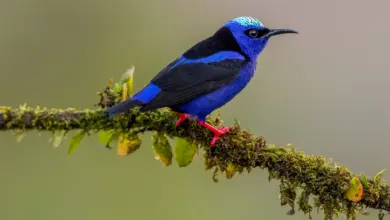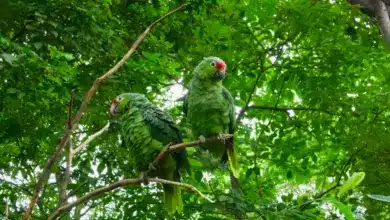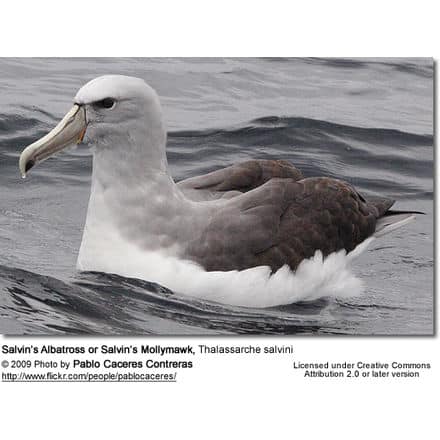Marbled Murrelets
The Marbled Murrelets (Brachyramphus marmoratus) is a small seabird from the North Pacific. It is a member of the auk family.
It nests in old-growth forests or on the ground at higher latitudes where trees cannot grow. Its habit of nesting in trees was suspected but not documented until a tree-climber found a chick in 1974 making it one of the last North American bird species to have its nest described.
Status
The Marbled Murrelet has experienced declines in their numbers since humans began logging their nest trees beginning in the latter half of the 1800s. The decline of the Marbled Murrelet and its association with old-growth forests have made it a flagship species in the forest preservation movement.
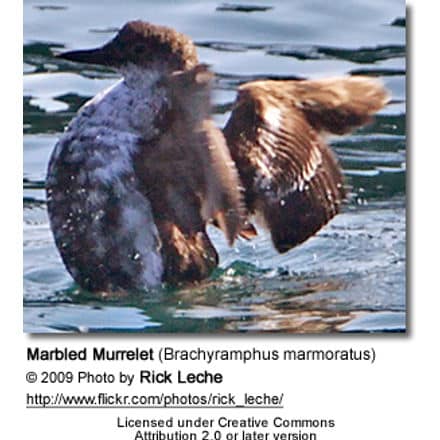
Description
The Marbled Murrelet is a small (25 cm), chunky auk with a slender black bill. It has pointed wings and plumage that varies by season.
The non-breeding plumage is typically white underneath with a black crown, nape, wings and back.
The bird closely resembles its closest relative, the Long-billed Murrelet. In fact, these species were considered conspecific (one species) up until 1998. They are virtually identical. In breeding plumage, both have a brown mottled body and face. The Long-billed has a pale white throat, lacking in the Marbled. In winter plumage, the Marbled Murrelet has a white neck collar, absent in Long-billed. The Marbled Murrelet is shorter billed and slightly smaller than the Long-billed Murrelet.


Behavior and breeding
The Marbled Murrelet feeds at sea both in pelagic (open seas) offshore areas (often associating with upwellings*) and inshore in protected bays. (*An upwelling is an oceanographic phenomenon that involves wind-driven motion of dense, cooler, and usually nutrient-rich water towards the ocean surface, replacing the warmer, usually nutrient-depleted surface water.)
It feeds principally on sandeels, also taking herring, capelin and shiner perch. The bird has not been known to wander from the Pacific coast of North America, all inland and eastern Brachyramphus records being of the closely related Long-billed Murrelet.
The sex behaviour of the Marbled Murrelet is very unusual, because unlike seabirds outside its genus it doesn’t nest in colonies. Instead, it nests on branches of old-growth and mature conifers such as Western Hemlock, Sitka Spruce, Douglas Fir and Coastal Redwood, as far as 80 km inland. It lays one egg on a platform of lichen or moss on these branches (less often on the ground). The egg is incubated for a month, then fed for around 40 days until the chick is able to fledge. The chick then leaves the nest and flies unaccompanied to the sea. Breeding success is low and chick mortality high.
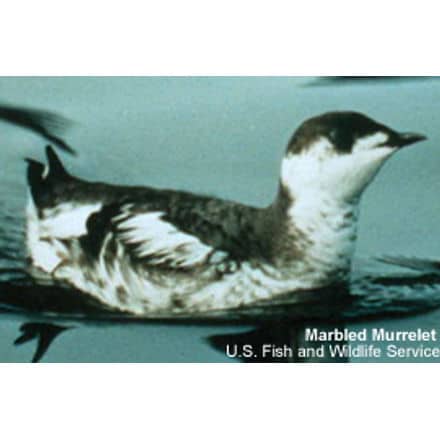
Marbled Murrelets and humans
The Marbled Murrelets is considered globally threatened, with some evidence of decline across its range over the last few decades. The biggest threat to the marbled murrelet was long considered to be loss of nesting habitat (old-growth and mature forests) to logging. Additional factors including high predation rates due to human disturbances and climate-driven changes in ocean conditions are also considered important now.
Scientists at Redwood National Park have established a connection between human presence in marbled murrelet territory and corvid predation of marbled murrelet chicks. Corvid populations, such as Steller’s jays, crows, and ravens, are expanding into old-growth forests. Lured by food scraps left by campers and hikers, with increased access aggravated by the patchwork forests created by industrial logging, corvids more frequently discover marbled murrelet nests in areas where these predator species were not previously found.
The populations in Washington, Oregon and California were listed as threatened in 1992 by the U.S. Fish and Wildlife Service due to concerns about loss of nesting habitat, entanglement in fishing gear and oil spills. The remaining populations (Alaska and Canada) are currently under review. The species became a flagship species in efforts to prevent the logging of old-growth forests along the Pacific coast from California to Alaska.


